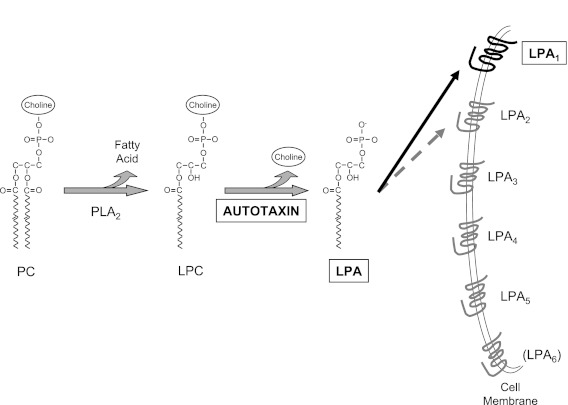Figure 1.
The autotaxin-LPA-LPA1 pathway. Generation of lysophosphatidic acid (LPA) by autotaxin, and LPA signaling through LPA1; both are required for bleomycin-induced pulmonary fibrosis in mice, and both have been implicated in the pathogenesis of idiopathic pulmonary fibrosis in humans. The majority of LPA in vivo appears to be produced by conversion of phospholipids such as phosphatidylcholine (PC) to lysophospholipids such as lysophosphatidylcholine (LPC) through the action of phospholipase A2 (PLA2) family members, followed by the conversion of these lysophospholipids to LPA through the lysophospholipase D activity of autotaxin. Once generated by autotaxin, LPA signals through specific cell surface G protein–coupled receptors: five high-affinity LPA receptors have been definitively established and designated LPA1 to LPA5; a lower-affinity receptor is likely to join the LPA receptor family as LPA6. LPA signaling specifically through LPA1 has pro-fibrotic effects on epithelial cells, endothelial cells, and fibroblasts, promoting epithelial cell apoptosis, inducing vascular leak, and directing fibroblast recruitment, proliferation, and persistence. LPA–LPA2 signaling may also have pro-fibrotic effects, inducing activation of latent TGF-β by lung epithelial cells, although LPA signaling through LPA2 on leukocytes may serve to prevent excess innate immune activation after tissue injury.

